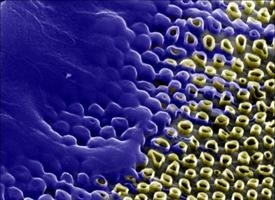Apr 7 2016
A new and highly efficient technique has been developed for gene transfer by a group of researchers from the University of Rochester Medical Center (URMC) and the Rochester Institute of Technology (RIT).
 A new and highly efficient technique has been developed for gene transfer by a group of researchers from the University of Rochester Medical Center (URMC) and the Rochester Institute of Technology (RIT).
A new and highly efficient technique has been developed for gene transfer by a group of researchers from the University of Rochester Medical Center (URMC) and the Rochester Institute of Technology (RIT).
In this technique, the cells are cultured and transfected with a genetic material on a carbon nanotube array. It has the potential to overcome the drawbacks of other gene editing techniques.
The researchers have described their device in the Small journal.
This platform holds the potential to make the gene transfer process more robust and decrease toxic effects while increasing amount and diversity of genetic cargo we can deliver into cells.
Ian Dickerson, Ph.D., Associate professor, Department of Neuroscience, URMC
“This represents a very simple, inexpensive, and efficient process that is well-tolerated by cells and can successfully deliver DNA into tens of thousands of cells simultaneously,” said Michael Schrlau, Ph.D., a co-author of the paper and an assistant professor in the Kate Gleason College of Engineering at RIT.
Gene transfer therapies have proven to be a promising technique in the medical field. New gene editing techniques, like CRISPR-Cas9, provide researchers with the ability to accurately target genetic code segments. This capability enables various potential new scientific and medical applications, from manipulating stem cells to fixing genetic defects and reengineering immune cells to combat cancer and infections.
At present, new genetic instructions are inserted into cells using many different methods. This includes the use of a gene gun for DNA injection into cells, “infecting” cells with a new genetic code using viruses, and using electrical pulses to create tiny holes in the cell membrane.
However, there are fundamental issues that will affect the efficiency of all these methods. These processes could only provide a few healthy cells for the scientists to work with, due to their high toxicity. They can only deliver a limited amount of genetic information or payload. Finally, they are both high cost and time intensive.
Masoud Golshadi, Ph.D., first author of the paper, fabricated the new device at RIT’s Schrlau Nano-Bio Interface Laboratory. The researchers used the chemical vapor deposition method to produce a structure similar to a honeycomb, composed of millions of closely packed carbon nanotubes with openings on either side of a thin disk-shaped membrane.
At the Dickerson Lab at URMC, a variety of animal and human cells were cultured using the device. This was followed by bathing the cells in a medium containing liquid DNA for 48 hours. The genetic material is inserted into the cells with the carbon nanotubes acting as conduits. Nearly 98% of the cells remained healthy, and 85% of them were effectively transfected with the genetic material.
The researchers are still exploring the DNA transfer mechanism, but they believe that the enhanced endocytosis method could play a role here. The enhanced endocytosis method allows cells to perform protein transfer back and forth via the cell membrane.
Various cell types were also successfully cultured using the device, including neurons, stem cells, and immune cells, which are generally hard to grow and keep alive. The device can be produced at a lower cost. The researchers are now involved in the optimization of the technology so that researchers can use it for the development of new treatments for various diseases.
Leslie Wright from RIT was a co-author of the study. The work received support with funding from the Schmitt Program on Integrative Brain Research, the American-German Partnership to Advance Biomedical and Energy Applications of Nanocarbon, Texas Instruments, the Feinberg Foundation, and the Weizmann Institute of Science.